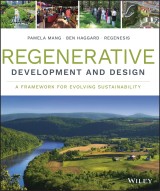Details
Regenerative Development and Design
A Framework for Evolving Sustainability1. Aufl.
|
68,99 € |
|
| Verlag: | Wiley |
| Format: | EPUB |
| Veröffentl.: | 02.08.2016 |
| ISBN/EAN: | 9781118972915 |
| Sprache: | englisch |
| Anzahl Seiten: | 272 |
DRM-geschütztes eBook, Sie benötigen z.B. Adobe Digital Editions und eine Adobe ID zum Lesen.
Beschreibungen
<b>The evolution of sustainability, with a practical framework for integration</b> <p><i>Regenerative Development and Design</i> takes sustainability to the next level, and provides a framework for incorporating regenerative design principles into your current process. The Regenesis Group is a coalition of experienced design, land-use, planning, business, and development professionals who represent the forefront of the movement; in this book, they explain what regenerative development is, how and why it works, and how you can incorporate the fundamental principles into your practice. A clear, focused framework shows you how to merge regenerative concepts with your existing work, backed by numerous examples that guide practical application while illustrating regenerative design and development in action. As the most comprehensive and systemic approach to regenerative development, this book is a must-have resource for architects, planners, and designers seeking the next step in sustainability. <p>Regenerative design and development positions humans as co-creative and mutually-evolving participants in an <i>ecosystem</i>—not just a built environment. This book describes how to bring that focus to your design from the earliest stages. <ul> <li>Understand the fundamentals of regenerative design and development</li> <li>Learn how regenerative development contributes to sustainability</li> <li>Integrate regenerative development concepts into practice</li> <li>Examine sample designs that embody the regenerative concept</li> </ul> <p>To create a design with true sustainability, considerations must extend far beyond siting, materials, and efficiency. Designers must look at the place, it's inhabitants, and the purpose—the <i>whole</i> living ecosystem—and proceed with their work from that more humbling perspective. The finished product should itself be an ecosystem and sustainable economy, which is the root of the regenerative development approach. Sustainability has evolved, and the designer's responsibility has increased in kind. <i>Regenerative Development</i> <i>and Design</i> provides an authoritative resource for those ready to take the next step forward.
<p>Foreword v</p> <p>Acknowledgments xi</p> <p>Changing Our Minds xiii</p> <p>The Future of Sustainability xix</p> <p><b>PART ONE: Creating Regenerative Projects 1</b></p> <p><b>Chapter 1: EVOLUTION 9<br /></b>Premise: <i>Every living system has inherent within it the possibility to move to new levelsof order, differentiation, and organization</i>.<br />Principle:<i> Design for evolution.</i></p> <p><b>Chapter 2: UNDERSTANDING PLACE 33<br /></b>Premise: <i>Co-evolution among humans and natural systems can only be undertaken inspecific places, using approaches that are precisely fitted to them.<br /></i>Principle: <i>Partner with place.</i></p> <p><b>Chapter 3: DISCOVERING COLLECTIVE VOCATION 61<br /></b>Premise: <i>The sustainability of a living system is tied directly to its beneficial integration into a larger system.<br /></i>Principle: <i>Call forth a collective vocation</i></p> <p><b>Chapter 4: THE GUILDED AGE 81<br /></b>Premise: <i>Projects should be vehicles for catalyzing the cooperative enterprises required to enable evolution<br /></i>Principle: <i>Actualize stakeholder systems toward co-evolving mutualism.</i></p> <p><b>PART TWO: Creating Regenerative Processes 103</b></p> <p><b>Chapter 5: START FROM POTENTIAL 11<br /></b>Premise: <i>Potential comes from evolving the value-generating capacity of a system to make unique contributions to the evolution of larger systems.<br /></i>Principle: <i>Work from potential, not problems.</i></p> <p><b>Chapter 6: VALUE-ADDING ROLES 135<br /></b>Premise: <i>The continuing health of living systems depends on each member living out its distinctive role.<br /></i>Principle: <i>Find your distinctive, value-adding roles.</i></p> <p><b>Chapter 7: TRANSFORMATIONAL LEVERAGE 153<br /></b>Premise: <i>Small conscious and conscientious interventions in the right place can create beneficial, system-wide effects.<br /></i>Principle: <i>Leverage systemic regeneration by making nodal interventions.</i></p> <p><b>Chapter 8: DEVELOPMENTAL WORK 177<br /></b>Premise: <i>A project can only create systemic benefit within a field of caring, co-creativity, and co-responsibility.<br /></i>Principle:<i> Design the design process to be developmental.</i></p> <p><b>PART THREE: Becoming a Regenerative Change Agent 197</b></p> <p><b>Chapter 9: SYSTEMS ACTUALIZING 20<br /></b>Premise:<i> The actualization of a self requires the simultaneous development of the systems of which it is a part.<br /></i>Principle:<i> Become a systems actualizer.</i></p> <p>Epilogue 215</p> <p>Further Reading 219</p> <p>Index 223</p>
<p><b>PAMELA MANG</b> and <b>BEN HAGGARD</b> are founding members of Regenesis Group, a coalition of experienced design, land-use, planning, business, and development professionals who focus on regenerative design and development. Regenesis was founded on the belief that environmental problems are more cultural and psychological than technological, and works to forward Living Systems Thinking as a framework for breaking the stagnation and developing a symbiotic relationship between people and the places they design and inhabit.
<p><b>A PRACTICAL, SYSTEMIC APPROACH TO REGENERATIVE DESIGN INTEGRATION</b> <p>The concept of "sustainability" is evolving. Applying sustainability at the building or project level fails to address the fundamental root of environmental problems: the fractured relationship between humans and nature. The Regenesis Group works to promote a framework in which humans are but a part of a larger whole, and projects are not end products, but the beginning of a process that brings an ecosystem together. <i>Regenerative Development and Design</i> explains the fundamental principles and practices of this new paradigm, and describes how they merge into every project, every design, and every designer. Case studies show how real-world projects are bringing regenerative development to life, and a practical integration framework helps streamline implementation in current and future projects. <ul> <li>Integrate evolution, place, community, and sustainability to make every project a catalyst for change</li> <li>Learn how small, opportune interventions can result in widespread systemic benefits</li> <li>Begin each project from a place of caring, co-creativity, and co-responsibility</li> <li>Understand how regenerative development fits into existing design practices</li> <li>Become an agent of regenerative change to help take sustainability to a higher level</li> </ul> <p><i>Regenerative Development and Design</i> is an authoritative resource for those seeking the next step forward toward true sustainability.


















